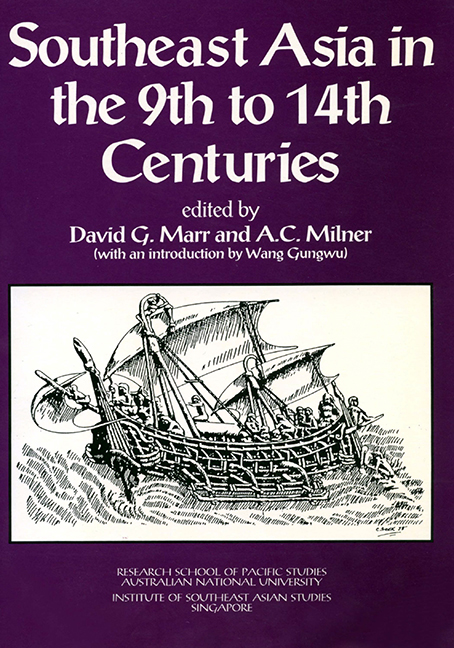Book contents
- Frontmatter
- Contents
- Contributors
- Preface
- Introduction
- 1 The Early and the Imperial Kingdom in Southeast Asian History
- 2 Hydraulic Works and South East Asian Polities
- 3 Some Notes on Relations between Central and Local Government in Ancient Java
- 4 Negara, Mandala, and Despotic State: Images of Early Java
- 5 Some Remarks on Early State Formation in Cambodia
- 6 “Elephants Can Actually Swim”: Contemporary Chinese Views of Late Ly Dai Viet
- 7 Authority and Legitimacy in 11th Century Vietnam
- 8 From Myth to History: Imagined Polities in 14th Century Vietnam
- 9 Shipshape Societies: Boat Symbolism and Political Systems in Insular Southeast Asia
- 10 Changing Perspectives in Island Southeast Asia
- 11 Political and Cultural Continuities at Dvaravati Sites
- 12 The True and the Corbel Arch in Mainland Southeast Asian Monumental Architecture
- 13 Vietnamese Ceramics and Cultural Identity: Evidence from the Ly and Tran Dynasties
- 14 Traditions, Acculturation, Renovation: The Evolutional Pattern of Vietnamese Culture
- 15 Symbolism of Kingship in Arakan
- 16 Buddhism in Champa
- 17 The Ordering of Generations: Change and Continuity in Old Javanese Kinship
- 18 Sources on Economic Activities in Khmer and Cham Lands
- 19 Narrative Bas-Reliefs at Candi Surawana
- 20 Possibilities for a Reading of the 1293-1357 Period in the Vietnamese Annals
- Index
- Miscellaneous Endmatter
11 - Political and Cultural Continuities at Dvaravati Sites
Published online by Cambridge University Press: 21 October 2015
- Frontmatter
- Contents
- Contributors
- Preface
- Introduction
- 1 The Early and the Imperial Kingdom in Southeast Asian History
- 2 Hydraulic Works and South East Asian Polities
- 3 Some Notes on Relations between Central and Local Government in Ancient Java
- 4 Negara, Mandala, and Despotic State: Images of Early Java
- 5 Some Remarks on Early State Formation in Cambodia
- 6 “Elephants Can Actually Swim”: Contemporary Chinese Views of Late Ly Dai Viet
- 7 Authority and Legitimacy in 11th Century Vietnam
- 8 From Myth to History: Imagined Polities in 14th Century Vietnam
- 9 Shipshape Societies: Boat Symbolism and Political Systems in Insular Southeast Asia
- 10 Changing Perspectives in Island Southeast Asia
- 11 Political and Cultural Continuities at Dvaravati Sites
- 12 The True and the Corbel Arch in Mainland Southeast Asian Monumental Architecture
- 13 Vietnamese Ceramics and Cultural Identity: Evidence from the Ly and Tran Dynasties
- 14 Traditions, Acculturation, Renovation: The Evolutional Pattern of Vietnamese Culture
- 15 Symbolism of Kingship in Arakan
- 16 Buddhism in Champa
- 17 The Ordering of Generations: Change and Continuity in Old Javanese Kinship
- 18 Sources on Economic Activities in Khmer and Cham Lands
- 19 Narrative Bas-Reliefs at Candi Surawana
- 20 Possibilities for a Reading of the 1293-1357 Period in the Vietnamese Annals
- Index
- Miscellaneous Endmatter
Summary
Introduction>/b>
It is widely accepted among scholars in Southeast Asian studies that Central Thailand from the sixth to the eleventh century A.D. was dominated by a single state known as Dvaravati with its capital city at Nakhon Pathom (Quaritch Wales, 1965 and Diskul, 1972: 4,5). Most of its population were Mons who embraced Buddhism as their principal religion. With the rise of Angkor from the tenth century, Dvaravati gradually declined and in the end was replaced by Lop Buri or Lavo, which was established by Khmer overlordship in Cambodia.
This reconstruction of Dvaravati history is based mainly on accounts of a state called To-lo-po-ti, mentioned in Chinese notes. This name can be restored as Dvaravti, which appears on an old coin of the seventh century and in the Ayuthya chronicle, where the name of the city is mentioned in full “… krung thep dvaravati sri ayuthya…”. Moreover, the existence of this early state is supported by the presence of religious monuments and art objects heavily influenced by the Post Gupta and Pala arts of India from the sixth to the ninth century. The similarity in art style in the archaeological evidence has led to what is known as the Dvaravati style. It is found all over the Chao Phraya Valley, and indicates a shared pattern of culture among cities, towns, and villages which were integrated into a state.
This paper argues that when one looks at Dvaravati from the perspective of the development and distribution of ancient settlements in the Chao Phraya Valley, the cultural similarity reflected in art style becomes obscure and does not clearly explain political organization and continuity of the state in this region. Instead, there are some differences that indicate that more than one political centre and state existed in Central Thailand.
Development and disribution of ancient settlements in the Chao Phraya Valley
The Chao Phraya Valley is the deltaic region formed by deposition of sediment from various river systems. From existing archaeological evidence, it is the oldest area of Central Thailand where sedentary human settlements developed and later became state and nation. Its geography and environment played an important role in providing a firm basis for such a development. In the first place, the entire area encompasses a large fertile lowland suitable for rice cultivation that can feed large numbers of people.
- Type
- Chapter
- Information
- Southeast Asia in the 9th to 14th Centuries , pp. 229 - 238Publisher: ISEAS–Yusof Ishak InstitutePrint publication year: 1986

